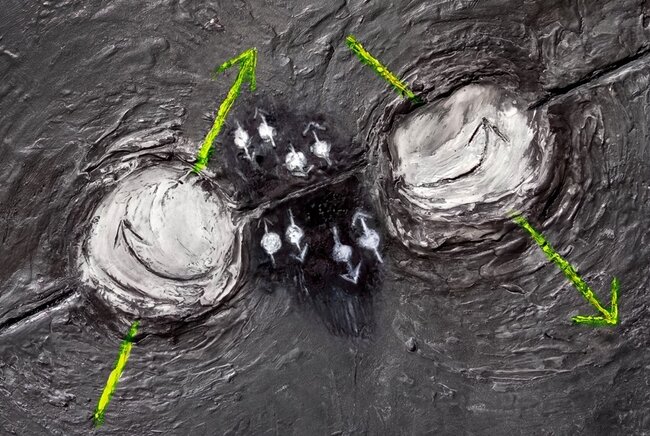New approach for Majorana research in short nanowires
Majorana particles are one of several promising candidates for stable quantum bits, the building blocks of quantum computers.

Researchers and engineers from QuTech and Eindhoven University of Technology have created Majorana particles and measured their properties with great control. These Majoranas are so-called ‘poor man's Majoranas’, based on two quantum dots in a nanowire, which could be scaled up to a larger chain of quantum dots with more resilient Majorana behavior. Majorana particles are one of several promising candidates for stable quantum bits, the building blocks of quantum computers. The researchers. including Ghada Badawi, Sasa Gazibegovic and Erik Bakkers of TU/e, published their results today in Nature.
Quantum computers are a revolutionary technology, which have the potential to solve certain problems much faster than classical computers. That is because they use quantum bits, or qubits, which can represent both a 0 and a 1 at the same time. This allows quantum computers to perform multiple calculations simultaneously. The implementation of quantum computers and qubits holds significant potential for various fields, including drug discovery, financial modeling, and cryptography.
The Majorana particle
“Majorana particles can be made into a type of qubit and have garnered attention due to their unique properties,” explains Tom Dvir, first author of the Nature paper and postdoctoral researcher at QuTech—the quantum technology institute of the TU Delft and TNO. He continues: “Unlike conventional qubits, which are based on the properties of individual particles like electrons, qubits based on Majorana particles are more resilient against certain types of quantum errors, which is a major challenge in the development of scalable quantum computers.”
His colleague and co-first author Guanzhong Wang adds: “The desirable properties of the Majorana particles, and their exotic nature that allows to observe new scientific phenomena, motivated a large research effort, initially by academia and later also by industry. Research so far was predominantly based on material synthesis, aiming at engineering the right material properties so that devices made from them are immediately operable when cooled down to low temperatures.”
The new approach shifts the focus to electrical control, meaning that the researchers could observe and adjust the device while at low temperatures to bring forward the right conditions for Majoranas to appear.
Chain of quantum dots to separate electron halves
Wang: “Unlike regular qubits, Majoranas always appear in pairs and each pair forms a delocalized electron. That means that one part of the Majorana particle can reside on one end of a nanowire and the second part on the other end. To manipulate the Majorana particle we need to affect both ends at the same time. This makes them attractive for quantum computation because if one part is affected by noise, the other half will remain unscathed.”
The researchers start by producing two quantum dots close to each other, separated by a short semiconductor/superconductor nanowire. The quantum dots are electrically connected to each other in two ways. The first is by electrons hopping between both dots. The second involves pairs of electrons that simultaneously enter and leave the semiconductor/superconductor nanowire. The researchers have shown a new method to precisely control both processes, key to the formation of the Majorana particles.
Future work
“Currently, we are working with a simplified version of Majoranas,” explains Dvir, “using just two quantum dots. Our ultimate goal is to have more dots, perhaps even as few as five, so that the electron halves are more widely separated. The further the Majorana particles are separated, the better the protection of the resulting qubits against noise.”
The difficulty of adding more dots to the device is expected to increase linearly, rather than exponentially. This is because we can tune each dot individually, allowing us to pinpoint the ideal configuration more easily.
Principal investigator Leo Kouwenhoven: “Looking ahead, there are two main objectives for the future. The first is to create a full topological Majorana based on the poor man's Majorana in this work. The second objective is to use these Majoranas to create qubits. This will require multiple copies of the system and further tuning."
More information
Tom Dvir, Guanzhong Wang, Nick van Loo, Chun-Xiao Liu, Grzegorz Mazur, Alberto Bordin, Sebastiaan ten Haaf, Ji-Yin Wang, David van Driel, Francesco Zatelli, Xiang Li, Filip Malinowski, Sasa Gazibegovic, Ghada Badawy, Erik Bakkers, Michael Wimmer & Leo Kouwenhoven, Realization of a minimal Kitaev chain in coupled quantum dots, Nature (2023), DOI
Media contact
More quantum and photonics research
![[Translate to English:] [Translate to English:]](https://assets.w3.tue.nl/w/fileadmin/_processed_/7/f/csm_BvOF%2001%20kickoff%20Future%20Chips%20Academy%20-%20group%20photo_5396222a83.jpg)
![[Translate to English:] [Translate to English:]](https://assets.w3.tue.nl/w/fileadmin/_processed_/a/9/csm_NGF%20Quantum%20Banner%20image_25d59cc135.jpg)

Latest news


